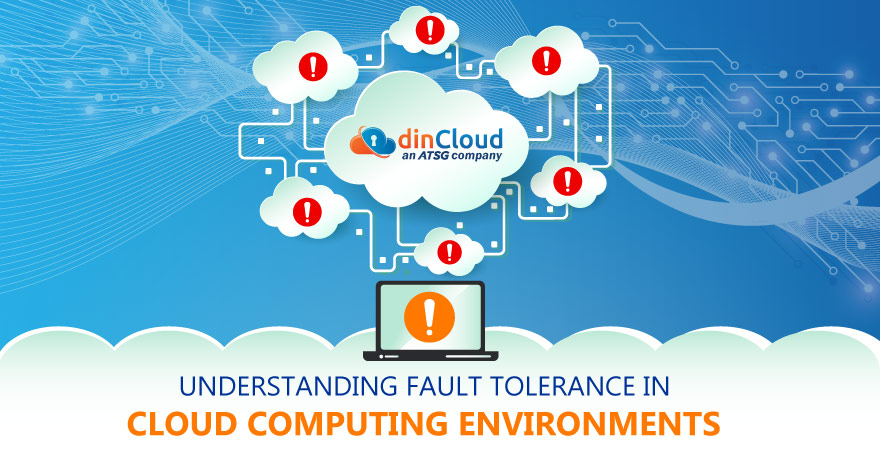The Cloud Computing footprint of enterprises is constantly on the rise. What this means is that an ever increasing number of enterprise processes and applications are now being handled by cloud deployments.
Although leading Cloud Service Providers (CSP) invest heavily in keeping their data centers and other hardware optimized, the possibility of a disruption cannot be ruled out completely. So, every enterprise needs to have a plan in place for such events.

What is Fault Tolerance in Cloud Environments?
Simply put, fault tolerance is the ability of any Cloud Computing environment to continue operating, despite a hardware failure or any other disruptive event. This concept can be correlated much better with Business Continuity (BC).
In today’s super competitive environment, downtime of even a few minutes can translate into a loss of thousands, or maybe millions of dollars. Even worse, any such small event can trigger a chain reaction, which an easily engulf other services that are not yet impacted.
Related: The Evolution of Digital Technologies in 2022; thru Deloitte’s Lens
Establishing the Fault Tolerance Bottom-line
The first step in preparing any Cloud Computing, or IT environment for a robust fault tolerance starts with establishing a baseline. In this process, an enterprise defines the core mission critical workloads or processes that it can’t afford to lose, at all.
The reason for adopting this approach is that establishing a robust fault tolerance involves financial and human resources. So, this posture cannot be established for every application, workload or process within the enterprise.
Once the mission critical processes have been defined, this works as a baseline for starting work on creating a robust fault tolerance mechanism for those operations. This is the ideal time for involving your cloud provider into the process as well, as it is really important.
Related: Why & How are Enterprises Moving towards Green IT in 2022?
How Do Cloud Providers Deliver Fault Tolerance?
The means of delivering a robust fault tolerance mechanism will vary with each individual Cloud Service Provider (CSP). As a leading CSP with years of industry experience, dinCloud ensures a robust fault tolerance posture through a global footprint of data centers.
These highly interconnected data centers provide failover support, in case there is any disruption at any one data center. When any such event is triggered, all your mission critical workloads, defined in the preceding stage, are migrated to another available data center.
So, the time it takes to identify the root cause and take remedial measures, all your mission critical workloads hosted in the Cloud remain uninterrupted. This option is way better than establishing a dedicated Disaster Recovery (DR) site, which is both costly and complex.
Related: Why Moving to Cloud Computing Still Makes Sense in 2022?
Testing and Evaluating Your Fault Tolerance
Enterprise operations are constantly evolving with ever changing business needs and priorities. So, it is very important for an enterprise to constantly evaluate its mission critical workloads, and communicate the same to the cloud provider as well.
With constant evaluation, the addition or removal of workloads from the fault tolerance bottom line would be a regular feature, keeping the Business Continuity (BC) and Disaster Recovery (DR) postures up to date.
Alongside this constant evaluation process of the fault tolerance is testing, which is an even more important feature. As an enterprise, you can’t first wait for something to fail, and then check whether the mechanisms you put in place do actually work or not.
Instead, a proactive approach is required in this regard, and this is where the role of putting your fault tolerance to the test comes into play. This exercise will truly reveal the efficacy of the mechanism you put in place, and if any tweaks are still required.
Testing the fault tolerance of your Cloud Computing environments also boosts the confidence level of the enterprise as a whole. This in turn translates into trusting customers and other channel partners, as they know they’re in safe hands.
Related: How to Navigate Cloud Security in 2022 – The Balanced Way?
Conclusion
Establishing a robust fault tolerance strategy and implementing it is absolutely important in today’s highly competitive environment. Leading Cloud Service Providers (CSP) like dinCloud make this seemingly difficult undertaking a seamless affair.
The very cloud infrastructure that supports your day to day operations in the Cloud, can also double down as your fallback, in the event of a disruption. This approach to fault tolerance is most effective if your CSP has a large data center footprint, like dinCloud.
Contact dinCloud, an ATSG company, which not only provides secure cloud services, but also delivers a robust fault tolerance posture, at a fraction of the cost incurred on establishing the same capability on-premise.


